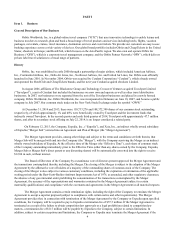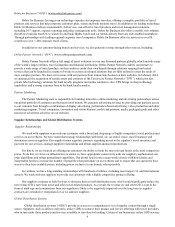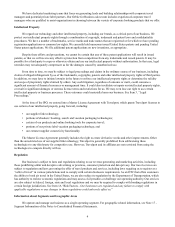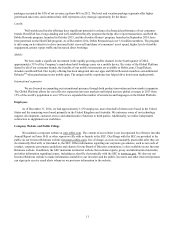Orbitz 2014 Annual Report Download - page 10
Download and view the complete annual report
Please find page 10 of the 2014 Orbitz annual report below. You can navigate through the pages in the report by either clicking on the pages listed below, or by using the keyword search tool below to find specific information within the annual report.10
Industry Conditions
General
Worldwide travel is estimated to be a $1.3 trillion industry in 2014 that has been characterized by rapid and significant
transformation driven by changes in demographic trends, globalization and higher consumer discretionary spending. The travel
industry continues to benefit from increasing internet usage and higher online and mobile booking penetration rates. We
compete in various geographic markets, with our primary markets being the United States, Europe and the Asia Pacific region.
Internationally, approximately one third of travel sales are transacted online and the market is highly fragmented, which
represents a significant opportunity for us. Phocuswright estimates that online travel bookings will grow approximately 11%
annually from $402 billion in 2013 to $492 billion in 2015, with annual growth of approximately 6% in the United States, 8%
in Europe and 15% in the Asia Pacific region. (Phocuswright, Global Online Travel Overview, 3rd ed.).
In Europe, OTCs represent 39% of the online market with gross bookings of approximately $50 billion (Phocuswright,
European Online Travel Overview, 10th ed.), while OTCs account for 36% of the Asia Pacific online travel market with gross
bookings of approximately $30 billion in 2013 (Phocuswright, Asia Pacific Online Travel Overview, 7th ed.).
Competition
The general market for travel products and services is highly competitive, and the competitive intensity is increasing as
the market rapidly evolves. The online travel industry generally has low barriers to entry and competitors can launch new
websites at a relatively low cost. Our competition includes: online and offline travel companies; travel suppliers, such as
airline, hotel and rental car companies, many of which have their own branded websites and call centers; travel research
companies; search engines; and meta-search websites.
Our competition may offer more favorable terms and/or improved interfaces to suppliers and travelers. Travel suppliers
have increasingly focused on distributing their products through their own websites, or through joint efforts, in lieu of using
third parties such as OTCs. Suppliers who sell their products on their own websites often offer advantages such as their own
bonus miles or loyalty points not available on our sites, which may make their offerings more attractive than our offerings to
some consumers. Travel research companies, search engines and meta-search websites are capable of sending customers to the
websites of suppliers and other competitors.
Factors affecting our competitive success include price, availability of travel products, ability to package travel products
across multiple suppliers, brand recognition, customer service and customer care, fees charged to customers, ease of use,
accessibility, reliability and innovation such as offering our own custom loyalty programs.
Seasonality
Our businesses experience seasonal fluctuations in the demand for the products and services we offer. The majority of
our customers book leisure travel rather than business travel. Gross bookings for leisure travel are generally highest in the first
half of the year as customers plan and book their spring and summer vacations. However, net revenue generated under the
merchant model is generally recognized when the travel takes place and typically lags bookings by several weeks or longer. As
a result, our cash receipts are generally highest in the first half of the year and our net revenue is typically highest in the second
and third calendar quarters. Our seasonality may also be affected by fluctuations in the travel products our suppliers make
available to us for booking, the growth of our international operations or a change in our product mix.
Company Strategy
We take advantage of our deep roots in technology and innovation to offer consumers the premier way to book online
travel, whether via personal computer, tablet or smartphone. We believe the Global Platform is the cornerstone of our ability to
rapidly and efficiently innovate and expand into new markets with new products and services. Our mission is to make our
brands the world’s most rewarding places to plan and purchase travel on touch devices.
Strategic focus on hotel
We operate a diversified business model, enabling us to offer customers a broad product offering that is undergoing a
strategic mix shift towards hotel and vacation packages. In 2014, standalone hotels contributed 38% to net revenue, vacation
packages contributed 16% to net revenue and standalone air contributed 28% to net revenue. Collectively, hotels and vacation























